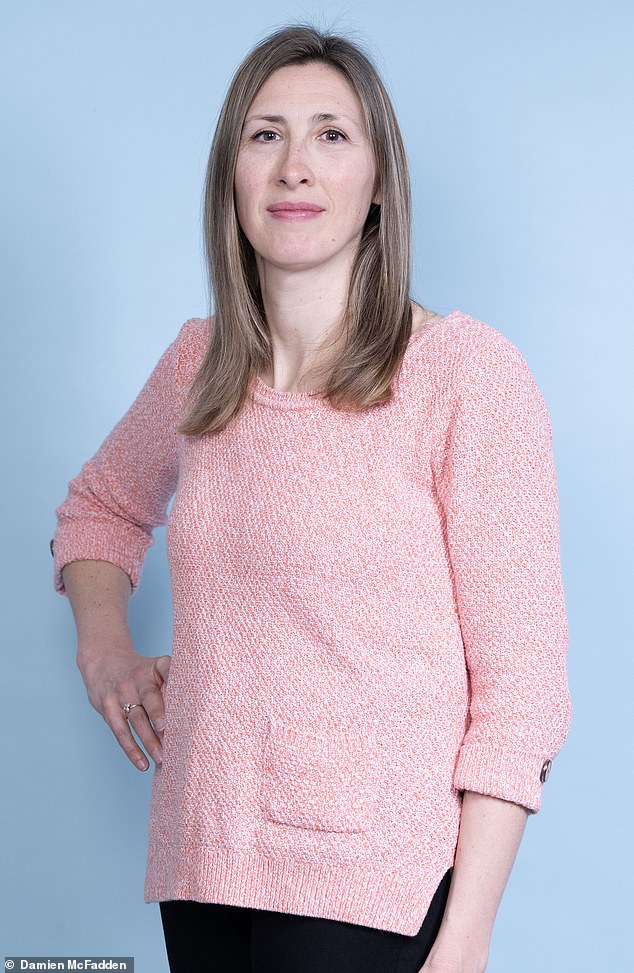Six weeks after the birth of her first child, Jane Kent was hit by such excruciating back pain it became almost impossible to pick up her baby or even turn over in bed.
‘I couldn’t do anything without pain, just lying down would send my back into agonising spasms,’ she says.
Jane’s GP assured her it was just the after effects of pregnancy but, over the next few months, her pain showed no signs of easing – and Jane noticed she appeared to be shrinking.
At 5 ft 10 in, she was used to reaching things on the top shelf with ease, but this was no longer the case.
But her doctor didn’t seem concerned. ‘The GP told me that the loss of height and back pain were due to bad posture exacerbated by breastfeeding,’ says Jane, 44, now a mother of two, from Market Harborough, Leicestershire.
It would take nearly four years of going back and forth to the GP to get to the bottom the problem – and only after her mum came to help out after the birth of her second child and pointed out how much she had shrunk did Jane pluck up the courage to go back to the GP once more.
‘Mum looked at me and said, “Something is not right here”,’ recalls Jane, who is a children’s book writer and editor.
‘She said, “You’ve gone from being way taller than me to being shorter than me. You’re clearly in pain all the time. You need to get some help”’.

Jane Kent, 44, had excruciating back pain and noticed she appeared to be shrinking. She was diagnosed with pregnancy associated osteoporosis and had the bones of a 90-year-old
This time Jane spoke to a locum GP who, when she told her about her shrinking, finally referred her for an X-ray.
To Jane’s horror this revealed her back was fractured in ten places. The bones in her spine had collapsed so much her ribs had sunk inside her pelvis and she had lost five inches in height.
‘I was only 41 and they said I had the bones of a 90-year-old,’ says Jane.
She was told the cause of her weakened bones was pregnancy associated osteoporosis (PAO).
Most of the 3.5million cases of osteoporosis in the UK occur as a result of ageing, and a mismatch between the rate that old bone is broken down and new bone is created, leading to a loss of bone overall – but in cases such as Jane’s it occurs as a result of pregnancy.
All women lose some bone during pregnancy and breastfeeding as the growing baby takes calcium (needed to strengthen bone) from the mother.
Normally women lose 3 to 5 per cent of the calcium in their bones, but this is replaced when breast-feeding stops.
‘One theory is that, for reasons unknown, in women with PAO that process is exaggerated,’ says Professor Stuart Ralston, an expert in bone diseases at the University of Edinburgh.

Professor Stuart Ralston, an expert in bone disease at the University of Edinburgh, says women with a family history of osteoporosis are most at risk
Women with a family history of osteoporosis and those who have previously broken bones are most at risk, he says, but taking drugs used to prevent blood clots during pregnancy may also be a factor.
Some women develop it due to having low bone density before their pregnancy – for example, as a result of genetics, a history of anorexia, taking certain drugs including some steroids, or drugs to treat breast cancer.
‘In these women, the bone loss associated with pregnancy can tip them over the edge,’ he adds.
In the pregnancy-specific form of the condition, the spine seems to be the main site. Women might not even be aware they have the disease until they are struck by the sudden onset of excruciating pain, often the first sign of a break, says Professor Ralston.
‘Women are often shocked by it. They are doing fine and then suddenly they have all these fractures out of the blue.’
Though it is estimated that 2,000 to 3,000 women in the UK are affected at any one time, experts believe the true figure may be far higher.
Dr Christopher Kovacs, of Memorial University of Newfoundland in Canada, a world leading authority on PAO, says: ‘Pregnancy and lactation-associated osteoporosis is under-recognised and under-reported, given how common back pain is in pregnancy.’
Professor Ralston says that unlike with age-related osteoporosis, bones affected by PAO can recover some density naturally. And once diagnosed, those affected will be prescribed calcium, vitamin D and drugs including bisphosphonates which slow down the rate at which bone is broken down. But campaigners say all too often early warning signs of POA are missed until serious damage has been done.

An estimated 2,000 to 3,000 women in the UK are affected by pregnancy associated osteoporosis at any one time, but experts believe the figure may be far higher
Karen Whitehead, 63, who was diagnosed with PAO nearly 34 years ago, is launching a charity, Pregnancy Associated Osteoporosis UK, to raise the profile of the condition.
She is campaigning under the hashtag #measurethatmum for three things to be recognised as red flags: extreme back pain, a mum struggling to care for herself and her baby and loss of height. And she is calling for new guidelines to help doctors identify it earlier.
Karen is frustrated she comes across so many new mothers who have exactly the same problems as she had three decades ago. ‘They’ve been dismissed medically,’ she says. ‘They really struggle to get diagnosed while they are continuing to fracture.’
Jane is a living example of the awful toll the condition can take if left unchecked. In a handful of years, she has gone from being a tall, slim and athletic woman who loved yoga, to a shrunken figure, hunched over, in constant pain and terrified of hurting herself,
‘I can’t stand up for very long. I can’t walk very far. I can’t carry anything that’s particularly heavy.’ She had some back pain while pregnant with her first son Ben in 2019 but ‘nothing major’.
Then about six weeks after giving birth, ‘I went to lift him out of the cot and felt my back go. It was really painful, but you just assume you’ve pulled a muscle.’
The pain radiated from the bottom of her spine to the top, and went around her ribcage.

What upsets Jane the most that her diagnosis has affected her parenting and that it led to the breakdown of her marriage. She says her children ‘missed out’ due to the agonising condition
When the GP dismissed it as the after effects of pregnancy, she went to see a private physiotherapist who gave her stretching exercises, but the pain never really went away.
When Jane became pregnant with her second son in 2021, she went to an NHS physio and was given some more exercises – this time she was diagnosed with sciatica, which is a common type of back pain.
At several appointments, Jane reported she had lost inches in height, yet nobody ever seemed unduly concerned.
After her PAO diagnosis, Jane was given calcium supplements, daily self-administered injections of teriparatide, which helps strengthen bones, and infusions of zoledronic acid, a type of bisphosphonate. Annual bone scans show her bone density has improved but is still in the range for osteoporosis.
What upsets Jane more than anything is how it has affected her parenting.
‘I can’t rough and tumble with my children – now five and three – on the floor. When they were little, I couldn’t do any baby classes that involved putting them on the floor because I couldn’t pick them back up. So they missed out. I’ve missed out.’
She has a blue disability badge for her car and her marriage has broken down due to the strain of it all, she says.
A single mum, she moved to be near to her mother, who she describes as ‘my greatest support’, and her sister. ‘Motherhood is hard enough without having this extra layer of worrying that you’re going to hurt yourself or being in pain all the time.’
She is speaking out now to try to help improve awareness.
‘It’s not normal for pregnant women to lose height – that should have been a massive red flag in my case.
‘This has impacted my life so much, I just don’t want anyone else to suffer as I have.’
For more information see pao.org.uk or facebook.com/paogroupuk

